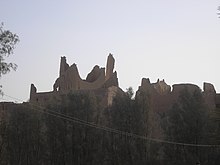Diriyya
Diriyya (also Diriyah , Arabic الدرعية, DMG ad-Dirʿiyya ) is now a north-western suburb of Riyadh with 33,213 inhabitants (2004). The original settlement is located directly on Wadi Hanifa and consists of low mud buildings that are now uninhabited and can be visited as a kind of open-air museum. The original inhabitants were traders and wadi farmers.
Diriyya is considered to be the nucleus of Wahhabism and home of the Al Saud family . Diriyya can be described as a kind of predecessor city of Riyadh. The at-Turaif district has been a World Heritage Site since 2010 .
Settlement structure
The name originally referred to the entire wadioasis, some of which were walled. This consisted of several settlement centers. With modern and European terms one could describe the place as a north-south stretched river valley about 4 kilometers long, with several villages, manor houses and the urban center at-Turaif. The wadi floor is covered with date gardens and other plantings, while the settlements are pressed against the sometimes quite steep slopes. At-Turaif, the last center of the oasis, lies on a wedge-shaped spur on the western slope of the wadi. The entire oasis was on the level into which the wadi cut itself (and on which today's riad is located), surrounded by walls with individual watchtowers. The Darischah tower is still relatively well preserved. Today's Diriyya open-air museum only contains the core of at-Turaif, which had its own city wall.
History and Development
Diriyya was founded in 1446. In the 15th century there were many resettlements and more intensive use of the oases in Najd . Ibn Dir, the chief of ad-Dir, a clan of the Bani Hanifa from Hajr, wanted to make better use of the wadi and in 1446 invited the Murada tribe, related to him, from the area of al-Qatif on the Persian Gulf to settle here. They founded the settlements of Mulaibid and Ghasiba on the eastern bank of the wadi and named the new place Diriyya, which also included all the settlements that were located on the four kilometers of the wadi that lay between the two places.
Ghasiba was the first main town of the Murada "wadi oasis" Diriyya in Wadi Hanifa. The southern Najd was later ruled from al-Uyaina (in the northern wadi west of al-Jubaila). In the late 1680s, Muqrin bin Marchan made at-Turaif on the western bank of the Wadi the capital of Diriyya. From 1725 Diriyya ruled the southern Najd under Muhammad ibn Saud (1735-1765), the founder of the first Saudi state.
On the eastern bank of the Wadi across from at-Turaif is the place Budschairi , where the family of Sheikh Muhammad ibn Abd al-Wahhab (1703–1792) resided after they were expelled from al-Uyaina. After 1745 this became more important than the Sheikh Muhammad Ibn Saud, who resided in at-Turaif, joined the reform movement of the Wahhabis and in 1744 made a pact with the Imam Muhammad bin Abd al-Wahhab. The Al Saud brought most of the Arabian Peninsula under their rule and advanced into the Hejaz , where they conquered Mecca in 1806 .
In at-Turaif the Imam Saud I ibn Abd al-Aziz (Imam 1803-1814) completed the Salwa palaces. The most famous builder of this time in Diriyya was Ibn Hazam.
The Ottoman Sultan Mahmud II wanted to restrict the new power on the Arabian Peninsula. During the Ottoman-Saudi War he sent his Egyptian governor Muhammad Ali Pasha on a campaign against the Saudis in the Naj.
The oasis was attacked in 1818 by Ibrahim Pascha , the son of Muhammad Ali Pascha, and fell after a six-month siege in September by a breakthrough in the north after previous attacks on at-Turaif from the south through the Wadi Scha'ib Safar were unsuccessful . The most important members of the Saudis clan were imprisoned and some were abducted or executed.
The following year Diriyya was completely destroyed, and the hamlets of at-Turaif and Ghasiba remained in ruins to this day (in the 1960s there were attempts to settle in at-Turaif and by the 1990s the early palace of Sa'd and the Qasr had been found Nasr restored).
The new town of Diriyya is about two kilometers east of Wadi Hanifa. The development is predominantly two-story.
See also
literature
- Old Dariyyah - aldir'iiyah alqadimah. Department of Antiquities and Museums, Ministry of Education, Kingdom of Sauidi Arabia 1975.
Web links
Individual evidence
- ↑ Mey Dudin : Der Pakt , PM History # 9/2017, pp. 72-77.
- ↑ Entry at-Turaif on the Unesco website, accessed on June 20, 2015 (multilingual)
Coordinates: 24 ° 44 ' N , 46 ° 35' E



